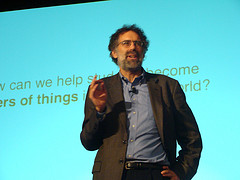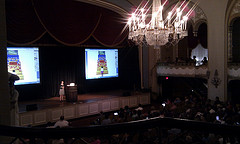
Overcoming Our Fears
(Cross Posted on November Learning)
When it comes to keynote speakers, nobody can ever match the line-up that the November Learning team puts together for BLC. Once again an amazing line up of thinkers outside of K-12 Education stretching us to think where we need to be taking kids and schools.
Mitch Resnick opened the conference with a very simple message:
Students should be creating on the web
 I couldn’t agree more and not just creating for themselves and their classmates, but for the world. Using Scratch as his basis for his talk, Resnick took us on a journey of how students are using Scratch to create, share, remix, and collaborate on creating some pretty cool projects, most of them outside of school.
I couldn’t agree more and not just creating for themselves and their classmates, but for the world. Using Scratch as his basis for his talk, Resnick took us on a journey of how students are using Scratch to create, share, remix, and collaborate on creating some pretty cool projects, most of them outside of school.
Resnick’s message aligned perfectly with an article I read in Inc. Magazine last week titled: Revitalizing the American Dream. A fascinating read on how entrepreneurship needs to be revitalized in America.
It’s important to note the view point in which I’m coming from on this next bit. A little history on me: I’ve lived overseas for the past 8 years and when people ask me where I’m from..I hesitate, as do most expats. It’s a hard question to answer. I’m an American and proud to be one, but in the past 8 years America has felt less and less like “home” and more and more like a foreign land. Over these last 8 years, I’ve had the opportunity to visit America only during the summer holidays and at the same time visit 35 other countries.
What I have observed being a some-what outsider to America is the fear that has captivated our country. A fear that I believe is stifling creativity in the country, in our schools, and in our daily lives.
What saddens me most is this country was founded on the idea of anyone can make it. The “American Dream” is written into our Declaration of Independence.
In the American Dream, first expressed by James Truslow Adams in 1931, citizens of every rank feel that they can achieve a “better, richer, and happier life.”[1] The idea of the American Dream is rooted in the second sentence of the Declaration of Independence which states that “all men are created equal” and that they are “endowed by their Creator with certain inalienable Rights” including “Life, Liberty and the pursuit of Happiness.”[2] (Wikipedia, 07/14/2010)
(Too bad the writers didn’t include an unfiltered Internet in that!)
Does this still hold true? Do kids today feel like they can grow up to be anything within our schools? The same schools that block much of the content that allows them to be creative, to communicate with others, and to create opportunities for themselves?
I’m sure many of you have either said this or have heard someone who has said this.
Alan November kicked off the conference today with one simple message:
We need to break down the Firewall fear
The same country that believes in free speech and the freedom of the press is the same country with some of the most restrictive filtering systems in its schools.
I lived for three years in Shanghai, China behind what is known as the “Great Firewall“. As much press as the “Great Firewall” gets for censoring some information and some tools, it is less restrictive than most filtering systems here in American Schools.
We need to break through this culture of fear, we need to empower students to make decisions, to analyze and evaluate good content and learn how to avoid the bad stuff. We need to empower students to protect themselves.
Mitch Resnick asked the question: How can we help students become makers of things in the digital world?
To do this we must first overcome our fear of putting student content out on the open web. It’s not as scary of a place as the media makes it out to be. At my school (International School Bangkok) we have over 1,000 student blogs with over 6,000 blog posts. In the two years we’ve been using blogs we have not had one bad comment or one bad blog post. Yes students get spam comments from time to time, and much like the spam they get in their e-mail they just delete it (Have you ever heard a student complain about spam? They don’t, it’s just a part of digital life that they’re used to).
It’s not just making things in the digital world, because making thing is only half the battle. The other half is finding ways to share those artifacts with the world. Creating something isn’t fun unless you can share it. Very rarely do we create anything just for ourselves. We create things to be shared with others, to share with others, and to be proud of. Once we overcome the fear of access we must overcome the fear of sharing.
Of course once we share our digitally made creations they can be remixed and as Resnick stated, “Being remixed should be an honor.”
We should be encouraging our students to remix, to use, and collaborate with others on ideas. We should be encouraging students to join Facebook groups around a cause, or remixing a Scratch game, or editing a Wikipedia article. Being remixed is an honor, it’s having someone take your blog posts and enhance it with their own ideas, it’s being retweeted on Twitter, and being talked about in a podcast.
 Creativity and fear do not mix. Trying to be creative in a culture of fear is nearly impossible. It’s difficult for teachers and it’s difficult for students.
Creativity and fear do not mix. Trying to be creative in a culture of fear is nearly impossible. It’s difficult for teachers and it’s difficult for students.
Adora Svitak ended the day on the same note in which it started. This time coming from the mouth of a 12 year old, Adora talked about how our fear of the tools as teachers, our fear of change, is blocking what she calls innovative classrooms. If we are to be innovative in our schools, as well as society, we must overcome our fears of the unknown. If we truly want our students to be creative and we believe that we are endowed by our Creator with certain inalienable rights including “Life, Liberty and the pursuit of Happiness,” then we need to overcome our fear of the Internet and embrace the global audience that awaits.








Jeff I agree all the way. Unfortunately, the people who need to read your post and hear those inspirational speeches are not listening. The key to the filters is held and guarded tightly by non educators in the US, I’m guessing around 95% of the time. Those are the folks controlled by fear. Teachers, I believe, are ready and waiting for the opportunity.
Hi Jeff:
I too have been at BLC 10 and agree that we need to live less in fear. I see the fear not only around the web, but also around issues like having the students go outside to learn. The students are made to be scared of ticks, mosquitoes, poison ivy. So, we need to overcome fears in many different avenues these days. Students need to be able to be creative in many different areas. The filters need to be taken down and the filters around going outside also need to be taken down. Let kids do what they do best, be creative.
I agree with Mark. Many teachers are ready and waiting. But many just don’t want to learn new skills. As long as our teachers are seemingly ignorant of technology- it will always be limited in the classroom. Even those of us who are pressing for it will be limited, because most district technologies are controlled by district level IT gurus who hold all the keys. They can’t let us loose and keep the digital leash on others. Someone please give me some insight on how to open the flood gates?
I teach at a high school in Maine. Our school just got 1:1 laptops last year and nothing was really blocked-the flood gates were opened and it has been a learning process. I was opened to the world of teenagers that I hadn’t seen before and it was enlightening. My son is 7 and loves using my computer any opportunity he gets. We are constantly engaging in conversations about how to use the computer responsibly and I am excited to see the things that he will come up with creatively. By the time he is in 5th grade, he will have a laptop from his school. He is a student who has a hard time sitting and needs to be active and doing. I think he will be able to explore his creativity more with having his own lap top at school, provided his teachers learn how teach creatively with them.